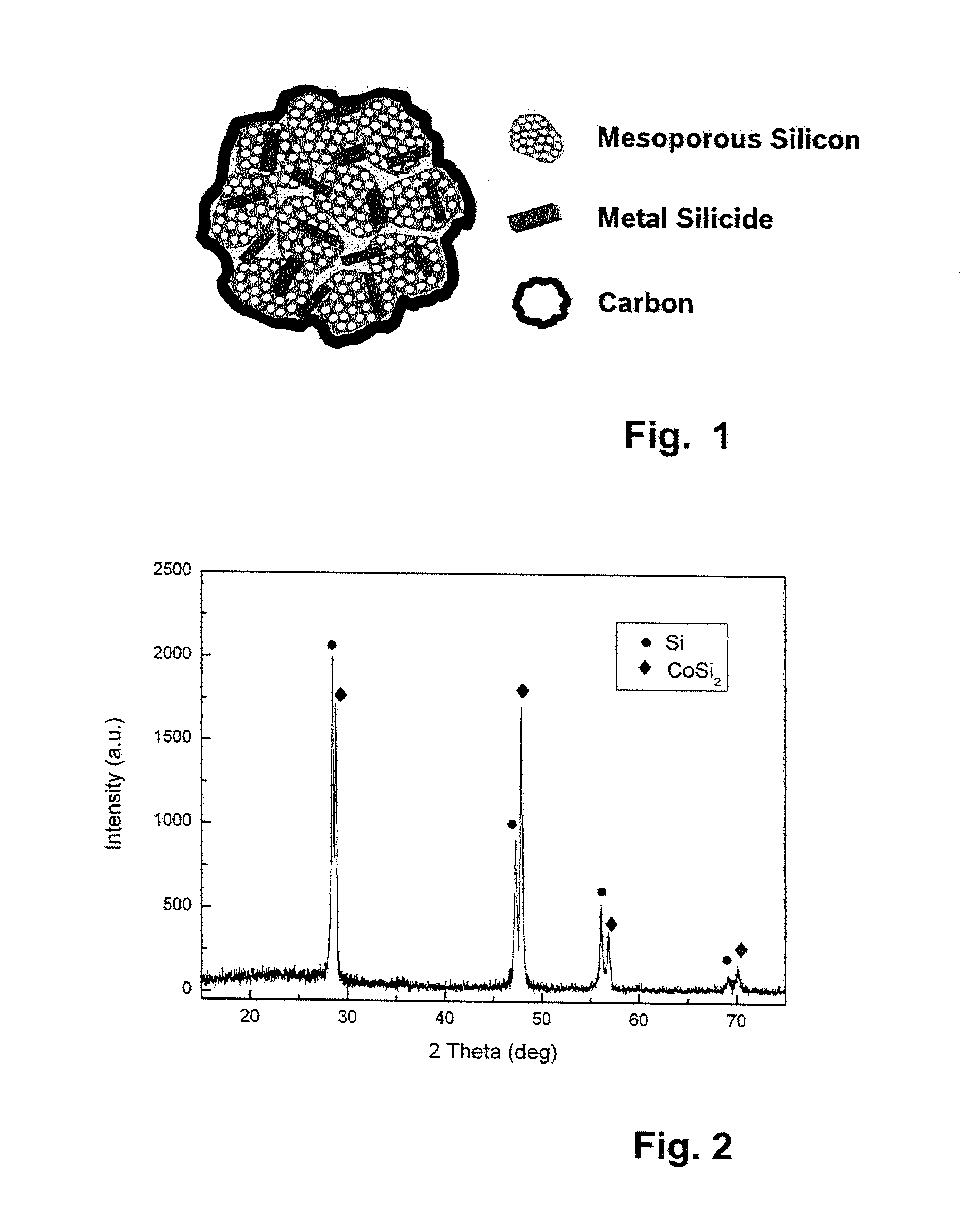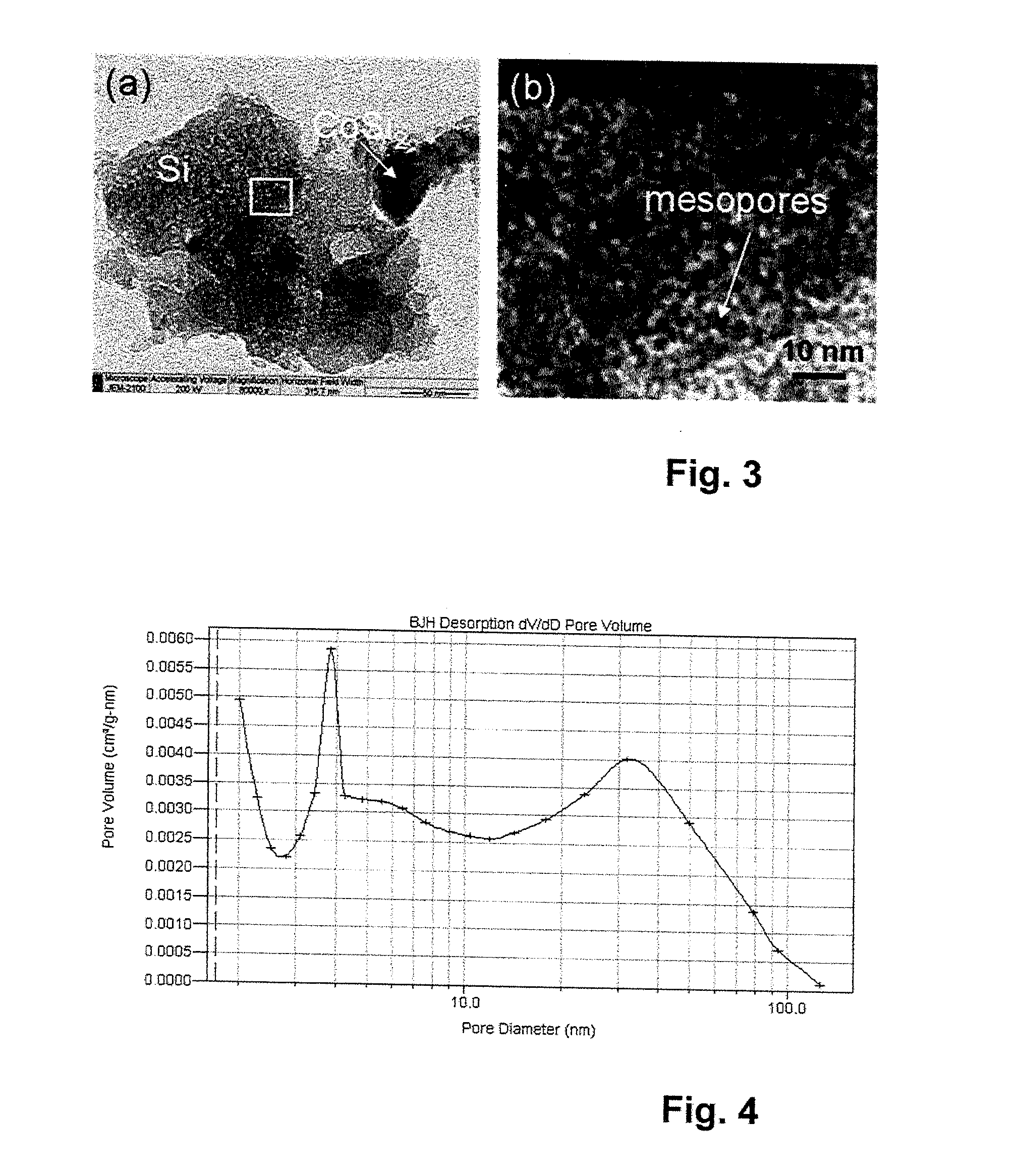Mesoporous Silicon Compound used as Lithium-Ion Cell Negative Electrode Material and Preparation Method Thereof
- Summary
- Abstract
- Description
- Claims
- Application Information
AI Technical Summary
Benefits of technology
Problems solved by technology
Method used
Image
Examples
example 1
[0075]2 ml of SiCl4 (Aladdin-reagent Inc., China, purity: 99.9%), 0.84 g of Li13Si4 powder (SIMIT, CAS, China), 0.15 g of cobalt powder (200 mesh, Sinopharm Chemical Reagent Ltd.) and 0.10 g of Super P carbon black (40 nm, Timical) together with 15 agate balls having a diameter of 10 mm were charged into a 80 ml argon-filled agate vial, and ball-milled at a rate of 450 rpm on Planetary Mono Mill P-6 (Fritsch, Germany) for 20 hours. Then, in an argon-filled glove box, the product just mixed (main components: Si / CoSi2 / LiCl) was placed into a quartz tube, heated in a constant argon flow at a rate of 5° C.·min−1, held at 900° C. for 2 hours, and then naturally cooled to room temperature. After the heat treatment, the product (main components: Si / CoSi2 / LiCl) was washed with deionized water, centrifuged 4 times to remove LiCl completely, and then dried at 100° C. in vacuum for 4 hours to obtain a mesoporous silicon / metal silicide composite (Si / CoSi2). 1.1 g of the mesoporous silicon / metal...
example 2
Coating a Carbon Layer by CVD
[0082]2 ml of SiCl4 (Aladdin-reagent Inc., China, purity: 99.9%). 0.84 g of Li3Si4 powder (SIMIT, CAS, China), 0.15 g of cobalt powder (200 mesh, Sinopharm Chemical Reagent Ltd.) and 0.10 g of Super P carbon black (40 nm, Timical) together with 15 agate balls having a diameter of 10 mm were charged into a 80 ml argon-filled agate vial, and ball-milled at a rate of 450 rpm on Planetary Mono Mill P-6 (Fritsch, Germany) for 20 hours. Then, in an argon-filled glove box, the product just mixed (main components: Si / CoSi2 / LiCl) was placed into a quartz tube, heated in a constant argon flow at a rate of 5° C.-min−1, held at 900° C. for 2 hours, and then naturally cooled to room temperature. After the heat treatment, the product (main components: Si / CoSi2 / LiCl) was washed with deionized water, centrifuged 4 times to remove LiCl completely, and then dried at 100° C. in vacuum for 4 hours to obtain a mesoporous silicon / metal silicide composite (Si / CoSi2). The mesop...
example 3
Cobalt Chloride as the Cobalt Source
[0084]2 ml of SiCl4 (Aladdin-reagent Inc., China, purity: 99.9%), 0.84 g of Li13Si4 powder (SIMIT, CAS, China) and 0.10 g of Super P carbon black (40 nm, Timical) together with 15 agate balls having a diameter of 10 mm were charged into a 80 ml argon-filled agate vial, and ball-milled at a rate of 450 rpm on Planetary Mono Mill P-6 (Fritsch. Germany) for 20 hours. Then, in an argon-filled glove box, the product just mixed (main components: Si / LiCl) was placed into a quartz tube, heated in a constant argon flow at a rate of 5° C.-min−1, held at 900° C. for 2 hours, and then naturally cooled to room temperature. After the heat treatment, the product was washed with deionized water, centrifuged 4 times to remove LiCl completely, and then dried at 10° C. in vacuum for 4 hours to obtain porous silicon. 0.80 g of cobalt chloride (CoCl2.6H2O) was dissolved in 10 ml of ethanol, into which 1.34 g of porous silicon was also added, stirred homogeneously, dri...
PUM
 Login to View More
Login to View More Abstract
Description
Claims
Application Information
 Login to View More
Login to View More - R&D
- Intellectual Property
- Life Sciences
- Materials
- Tech Scout
- Unparalleled Data Quality
- Higher Quality Content
- 60% Fewer Hallucinations
Browse by: Latest US Patents, China's latest patents, Technical Efficacy Thesaurus, Application Domain, Technology Topic, Popular Technical Reports.
© 2025 PatSnap. All rights reserved.Legal|Privacy policy|Modern Slavery Act Transparency Statement|Sitemap|About US| Contact US: help@patsnap.com



